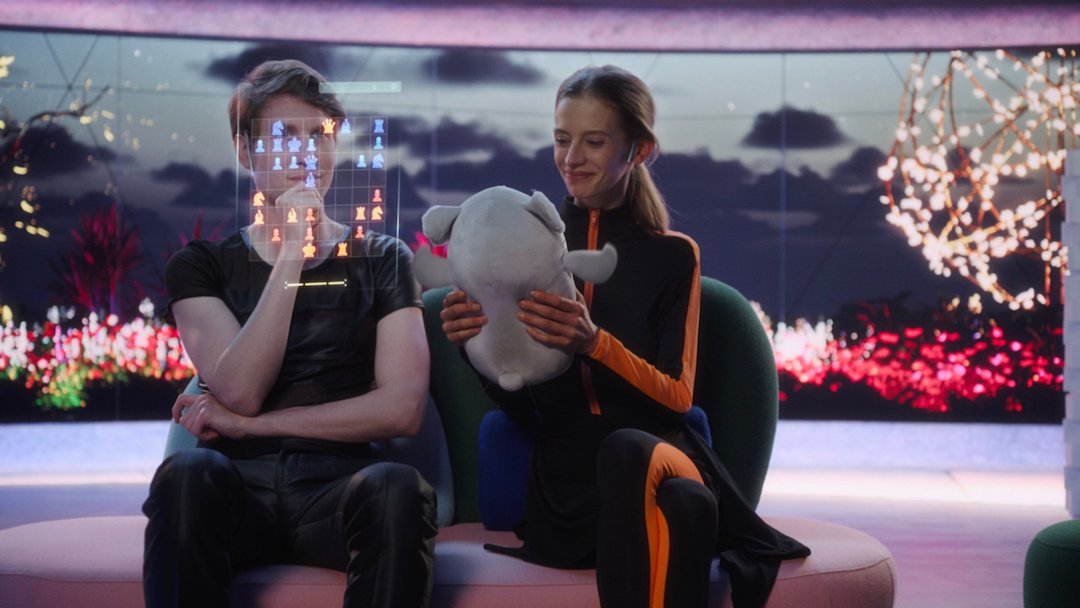
In her directorial debut, Raindance Film School alumni Sylvie Zaidman utilises 3D LED technology in her film, tRUTH, to explore the themes of human connection, technology’s place in modern society, and the impact of humankind’s reliance upon technology to interact with each other. tRUTH has been met with overwhelming success, having won multiple awards in addition to being selected for twenty three film festivals to date. When asked how the film’s concept came about, Sylvie explains “The idea for tRUTH came to me while I was walking around London in 2019. I saw a group of construction workers sitting next to each other, glued to their phones like robots. This image was etched in my brain, and I began to wonder what the world would be like if this dependency was taken to the extreme.”
Plot Synopsis
In the year 2050, technology reigns supreme in every aspect of daily life. Ruth, a young woman who appears to have a perfect life, is celebrating her seventh anniversary with her partner, Andrew, at a restaurant. After a brief stroll under the moonlight, they return home and prepare for a relaxing evening. However, Ruth receives a message notifying her that it’s time for her jogging session. She steps out onto her balcony where a treadmill awaits her.
Soon, the rhythm of the treadmill and her surroundings begin to change rapidly. Meanwhile, Andrew, engrossed in a game of chess, notices his screen malfunctioning. The treadmill’s relentless pace becomes impossible for Ruth to keep up with, causing her to collapse. Andrew tries to reach her, but the sliding glass door between them refuses to open. He manages to calm her down temporarily, until all the screens around them suddenly fail, plunging them into darkness.
Ruth and Andrew find themselves trapped in a grey cube, still separated by a glass barrier. Ruth becomes panicked as she realises her idyllic world is crumbling right before her very eyes. While attempting to console her, Andrew’s efforts prove to be in vain, and he drifts into his own thoughts for a brief moment. Growing increasingly desperate, Ruth pounds aggressively on the glass until it shatters and falls onto Andrew, causing him to collapse unconscious.
Frantically, Ruth tries to revive him, but to no avail. She clings to Andrew, filled with panic. Hours pass, and suddenly, Ruth gathers her strength and has an idea. She starts patting Andrew and, upon reaching his neck, discovers something unusual—a small hatch opens, revealing a button. Ruth presses it, and Andrew’s eyes flash with lines of code. It becomes evident that he too is a robot. Images with predetermined choices reappear on the walls, and Ruth feels content that everything has returned to normal. She nestles back into Andrew’s embrace.
Virtual Production and the 3D LED Wall in Filmmaking

Before diving into how virtual production and the 3D LED wall plays a central role in the filmmaking process for tRUTH, it’s important to note that there are three types of virtual production (VP) tools: visualisation, performance capture, and the live LED wall. Primarily utilised for live productions, the LED wall serves as the epitome of virtual production in its purest essence. It generates an image output using real-time rendering engines, which is then projected onto a screen located behind a physical set.
These LED scenes synergize with a motion capture volume that accurately tracks the camera’s position. This cutting-edge technology delivers breathtaking visuals and offers immense design flexibility, allowing modifications at any given moment.
How Sylvie Zaidman Pioneered the Use of 3D LED Technology in Filmmaking with tRUTH
During her first phone call about the project with fellow filmmaker Nic Shake, it was suggested that they achieve their goal of creating an environment that would align with the futuristic vision that they both had in mind. Because the use of 3D LED technology in film is so new and relatively untouched, Sylvie knew that she would have the opportunity to really think outside of the box and allow her creativity and imagination to lead the way, giving her an incredible advantage when it came to creating the environment she wanted for tRUTH.
Ironically enough, while the film’s concept is meant to serve as a warning of the dangers of relying on technology, it also played an important role in the filmmaking process. Having been filmed entirely using 3D LED displays, tRUTH is the first film of any length in France to have been filmed entirely using this technology. Sylvie says of her artistic choice, “For a movie with this message, it may seem paradoxical that it was shot entirely with 3D LED screens and no dialogue. But this time, it was very useful to get the result I wanted, and I am proud to say that tRUTH is the first movie entirely shot this way in France.” She elaborates, “I’m grateful to have been able to rely on this technology, which I’m sure will be used more widely in the future. And this is how it should be: technology should help us enhance our lives without becoming slaves to it!”
Sylvie Zaidman is a screenwriter, director and producer based in Antwerp, Belgium. Although she loved to perform since a young age, she initially trained as a lawyer, gaining a Master in European Law. Unhappy with her career choice, Sylvie moved to Paris in 2012 to pursue an acting career and was encouraged by a coach to start writing as “she had things to say”. Not wanting someone else to bring her own stories to life, she moved to London to study filmmaking. tRuth is her first professionel project. Having finally found her dream career, she is currently working on another short movie as well as a feature. She hopes to set up her own production company in the future.















